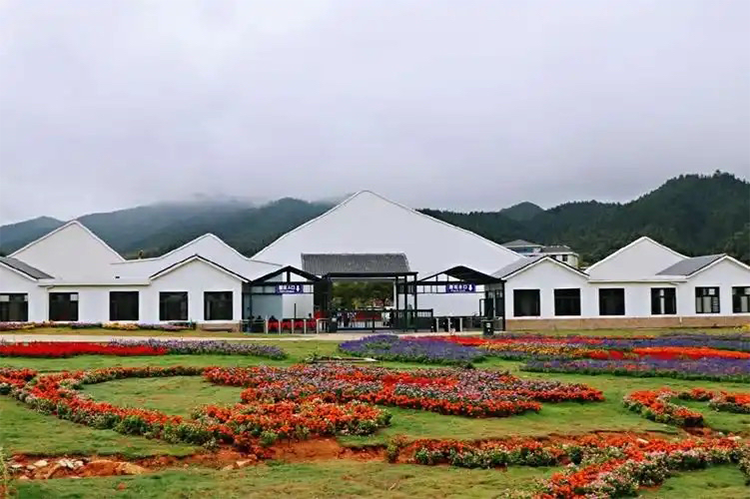Ancient Tea Road at Huajianli: Hidden Waterfalls and Hiking Guide
Introduction:
When a 30-meter waterfall plunges off a green cliff and sunlight splits the mist into rainbows, you can almost hear the distant clip-clop of Southern Song cavalry that once garrisoned here. Huajianli, tucked inside the primeval forests of Dayu County, Jiangxi, uses 90% forest cover to paint a moving landscape scroll. Interwoven fern-carpeted slopes hide Ming-era stone steps of an old courier road and Qing-era Hakka walled houses, each adding a breath of history to the terrain.
1. Soul interpretation: A living museum of landscape and culture
“One waterfall crosses a thousand years, the ancient road tells rise and fall”—this phrase sums up Huajianli. As a provincial forest park, it preserves one of southern Jiangxi’s best subtropical primeval forests and keeps alive Southern Song anti-Yuan history. Stroll beneath the shade of Chinese yew and you may encounter a cliff inscription linked to the patriot Wen Tianxiang. From the suspension bridge you can spot hoof marks left by Ming-era tea merchants. The park’s harmonious blend of nature and culture makes it far more than a typical forest park.
2. Time tunnel: From Southern Song battle smoke to Hakka village life
History unlocked
Two nationally protected relics inside the park tell of sweeping change: a Ming-era courier road paved with bluestone once connected Jiangxi and Guangdong as part of the tea-and-salt trade—over 300 surviving stone steps still bear wheel ruts worn by single-wheel carts. The Qing-era Hakka residence “Jiqingtang” displays classic walled-house architecture; its rammed-earth walls contain gun slits used historically for defense.
Legend and lore
In 1276 Wen Tianxiang reportedly set up an anti-Yuan command here; the cliff-carved inscription “Danxin zhao hanqing” commemorates that era. Local Hakka elders still tell stories of rebels using the waterfall’s roar to mask drill sounds. During Mid-Autumn, the old stage hosts a tea-picking opera adapted from this chapter of history.

3. A natural symphony: Year-round visual spectacles
Seasonal highlights
– Spring (March–May): Over 20 wild rhododendron species bloom along the stream; waterfalls run full—prime photography season.
– Summer (June–August): The forest is a natural air conditioner; nights offer firefly displays.
– Autumn (September–November): Sweetgum and Chinese tallow dye the valleys red; ginkgo and fallen leaves carpet the ancient road.
– Winter (December–February): Icicles freeze the waterfall into sculptural forms while camphor groves remain evergreen.
Microclimate phenomena
During the rainy season (April–June) the waterfall can form a “water curtain cave,” producing double rainbows when sunlight strikes at the right angle. Early-morning mist around the old houses creates ink-and-wash painting scenes. Photographers often stake out the viewpoint to capture the “Buddha light” phenomenon, most likely on clear mornings in May and October.
4. Deep-experience guide: From easy walks to immersive culture
Must-do routes
– 2-hour highlights: Visitor center → suspension bridge viewpoint → cliff inscription → Ming courier road (family-friendly).
– 5-hour exploration: Traverse primary forest to century-old camphor trees → follow the stream to the waterfall’s source (guided only).
– Signature activities: Hakka glutinous cake pounding experience (weekends); ancient-road tea ceremony demonstrations (daily at 11:00 and 15:00).
Eco-observation
Bring binoculars to spot pheasants, red-billed leiothrix and other species among the park’s 87 recorded birds. After rains you may find bioluminescent fungi on decaying logs. To protect the environment, the park limits daily entries and keeps visitor density below 50 people per square kilometer.

5. Practical info: Plan your serene escape
Getting there
– By car: 1.5 hours from Ganzhou city via the Daguang Expressway; free parking at the park.
– By bus: Dayu County bus station runs six daily tourist shuttles (departures on the hour between 07:00 and 16:00).
Tickets and bookings
– Entrance: RMB 80 (includes park shuttle); students half price.
– Book one day ahead on the official “Ganzhou Culture & Tourism” WeChat account for a 10% discount. Daily capacity is capped at 2,000 visitors.
Facilities
– Hakka restaurant serves local specialties such as stuffed tofu and pan-fried pork (approx. RMB 40 per person).
– Three eco-friendly restrooms with baby-care rooms are located across the park.
– English audio guides available at the entrance (deposit RMB 200).
When the late sun gilds the Qing-era horse-head walls and the waterfall’s roar blends with insect song, you’ll understand why China National Geography hailed Huajianli as the country’s most time-layered ecological secret. The park has no glass walkways or viral selfie spots—only deep cultural layers and raw natural power preserved for travelers seeking authenticity.


